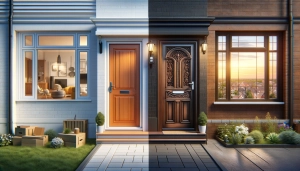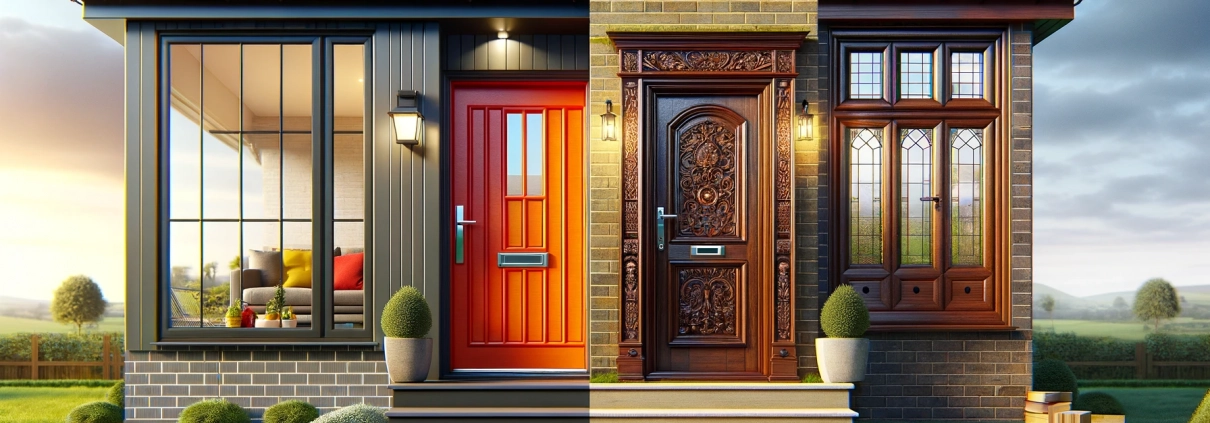UPVC vs Wooden Doors
Choosing Between UPVC and Wooden Doors: A Guide to Material Selection for Your Home
Table of Contents
Choosing the right material for your doors is as crucial as any other design decision you make for your home. In the world of door materials, UPVC and wood stand out as popular choices, each bringing its unique qualities and aesthetics. This article will explore these two materials, helping you understand which might be more suitable for your home.

Understanding UPVC Doors
What is UPVC?
UPVC, or unplasticized Polyvinyl Chloride, is a versatile and resilient material widely used in door manufacturing. Known for its strength and durability, UPVC is a low-maintenance and cost-effective option for modern homes.
Features and Benefits of UPVC Doors
One of the main draws of UPVC doors is their low maintenance. They are resistant to weathering, do not require painting or sealing, and are easy to clean, making them a practical choice for busy households. In terms of insulation, UPVC doors are excellent at retaining heat, contributing to energy efficiency in the home. While UPVC doors are often available in a variety of styles and finishes, they do lack the natural elegance that wooden doors offer.
The Timeless Appeal of Wooden Doors
The Natural Beauty of Wood
Wooden doors have been a staple in home design for centuries, prized for their natural beauty and warmth. The texture and grain patterns in wood offer an organic aesthetic that can’t be replicated by synthetic materials, making each wooden door unique.
Characteristics of Wooden Doors
Wood is not just about looks; it has functional benefits too. It’s a natural insulator, keeping your home warm in winter and cool in summer. However, wooden doors require more maintenance than UPVC. They need to be treated and painted regularly to protect them from the elements. Despite this, many homeowners find the classic appeal and customisable nature of wood to be worth the extra effort.
History and Evolution in Door Design
Evolution of UPVC Doors
UPVC doors have evolved significantly since their introduction. Early versions were often criticised for their plastic appearance, but advancements in design and technology have led to a range of finishes, including ones that mimic wood and metal, broadening their appeal.
Wooden Doors Through the Ages
Wooden doors have a rich history and continue to be popular due to their timeless elegance. Modern advancements in treatment and preservation techniques have enhanced the durability and functionality of wooden doors, ensuring they remain a classic choice in contemporary home design.
Aesthetic and Design Considerations
Customisation and Style in UPVC Doors
The aesthetics of your door play a pivotal role in the overall appearance of your home. UPVC doors offer a modern, clean look and come in various designs, including glazed and panelled options. They can also be customised with different colours and finishes, though the options are not as vast as with wood.
Wooden Doors – A Touch of Elegance
Wooden doors, on the other hand, are all about classic beauty and versatility. The natural grain of wood adds character and warmth, making each door distinct. They can be crafted in numerous styles, from rustic to sleek modern designs, and can be stained or painted in any colour, offering unparalleled customisation.
Durability and Longevity
Lifespan of UPVC Doors
UPVC doors are renowned for their resilience. They can withstand harsh weather conditions without warping, rotting, or corroding. This robustness translates into a long lifespan, often outlasting their wooden counterparts with minimal care. UPVC doors remain a steadfast choice for those looking for a durable and stable door option.
Endurance of Wooden Doors
Wooden doors, if properly maintained, can last for generations. However, they are susceptible to environmental factors like moisture and sunlight, which can lead to warping, rotting, or fading over time. Regular maintenance, including painting and sealing, is necessary to preserve their integrity and beauty.
Insulation and Energy Efficiency
Energy Efficiency of UPVC Doors
UPVC doors excel in terms of insulation. Their design typically includes multiple chambers within the frame, which trap air and provide an effective thermal barrier. This quality makes UPVC doors excellent at keeping heat in during the winter and out during the summer, contributing to lower energy bills.
Natural Insulation Qualities of Wood
Wood inherently has good insulating properties, making wooden doors effective at maintaining a comfortable indoor climate. However, their efficiency can be influenced by the quality of the wood and the construction. Proper sealing and fitting are essential to maximising their insulative performance.
Maintenance and Care
Upkeep of UPVC Doors
The ease of maintenance is one of the main advantages of UPVC doors. They require little more than a wipedown with soapy water to keep them looking fresh. They do not need repainting or sealing, which significantly reduces their long-term care requirements.
Caring for Wooden Doors
Wooden doors demand more attention to maintain their appearance and functionality. Regular painting or varnishing is needed to protect the wood from weathering and to prevent moisture damage. This upkeep, although time-consuming, can be seen as part of the charm of owning a natural product.
Cost and Value Considerations
Pricing of UPVC Doors
Generally, UPVC doors are more cost-effective, both in terms of initial purchase and long-term maintenance. Their durability and low upkeep make them a budget-friendly option, particularly for those looking for a functional, no-fuss solution.
Investment in Wooden Doors
Wooden doors tend to be more expensive than UPVC, reflecting the cost of natural materials and craftsmanship. However, they can add significant aesthetic and monetary value to a property. For those valuing traditional aesthetics and craftsmanship, the investment in a wooden door can be worthwhile.
Environmental Impact and Sustainability
UPVC Doors and the Environment
The environmental impact of UPVC doors centres around their production and disposal. While they are long-lasting, concerns exist over the recyclability and chemical processes involved in their manufacturing. However, strides in eco-friendly production and recycling processes are being made.
Sustainability of Wooden Doors
Wooden doors score well in terms of sustainability, especially if they are sourced from responsibly managed forests. The natural material is biodegradable and has a lower carbon footprint in production than synthetic materials. However, considerations around deforestation and the treatment chemicals used in preserving wood should be taken into account.
In conclusion, both UPVC and wooden doors have their merits and drawbacks. UPVC doors offer practicality, energy efficiency, and ease of maintenance, making them ideal for modern homes. Wooden doors, on the other hand, provide a timeless aesthetic, natural insulation, and the charm of craftsmanship, making them suited for those who value traditional elegance and are willing to invest in maintenance. Your choice will depend on your personal preferences, lifestyle, and the overall character you wish to impart to your home. Each material offers a unique blend of functionality and style that can enhance the appeal and comfort of your living space.





